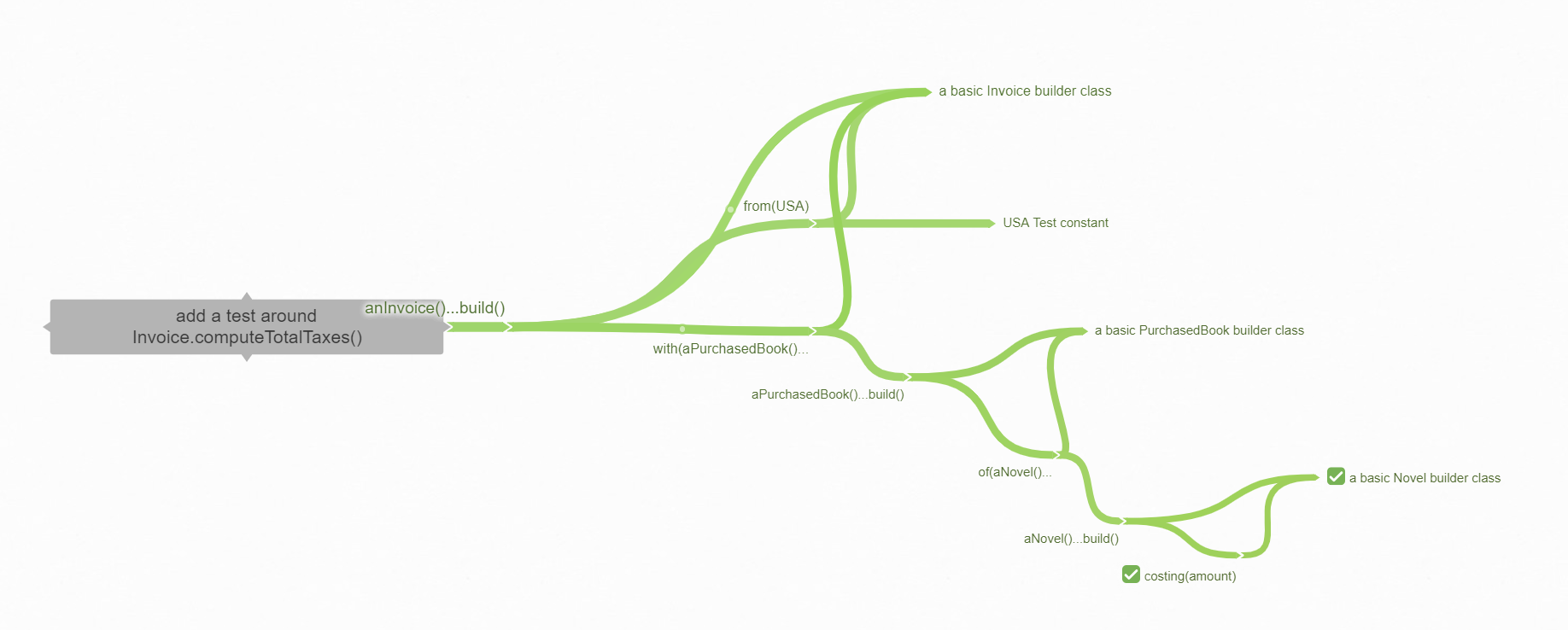Mikado Method + Test Data Builders
Test Data Builders make writing new tests faster once you have them. Unfortunately, they take even longer to write in the first place!
The Mikado Method does not make tests nicer, but they help you to write them incrementally.
Let’s combine both to get the best of both worlds!

Prerequisite
Make sure you master the Mikado Method and the Test Data Builders techniques before you try this constraint of the workshop.
If you don’t, start by going through the Building Test Data or the Mikado Method constraints first.
Rapid Response Question
As a group, what could you expect of combining The Mikado Method and the Test Data Builder pattern?
Live code the beginning of the Mikado Graph here
To help you to get started, here is a demo of how to use the Mikado Method in our particular situation.
Video Screen Shots
Mikado Graph
Screen-shot of the Mikado Graph from the video
Code Snippets
Code of InvoiceTest from the video
Java
package com.murex.tbw.purchase;
import org.junit.jupiter.api.Assertions;
import org.junit.jupiter.api.Test;
class InvoiceTest {
@Test
public void
applies_tax_rules_when_computing_total_amount() {
Invoice oneNovelUSAInvoice = anInvoice()
.from(USA)
.with(aPurchasedBook().of(
aNovel().costing(2.99))).build();
Assertions.assertEquals(2.99 * 1.15 * 0.98, oneNovelUSAInvoice.computeTotalAmount());
}
}
C++
TEST(InvoiceTest, applies_tax_rules_when_computing_total_amount)
{
Invoice oneNovelUSAInvoice = an_invoice()
.from(USA)
.with(a_purchased_book().of(
a_novel().costing(2.99))).build();
EXPECT_EQ(2.99 * 1.15 * 0.98, oneNovelUSAInvoice.computeTotalAmount());
}
C#
using Xunit;
using Application.Purchase;
namespace Application.Tests
{
public class InvoiceTest
{
[Fact]
public void Applies_Tax_Rules_When_Computing_Total_Amount()
{
Invoice oneNovelUsaInvoice = AnInvoice()
.From(USA)
.With(
APurchasedBook().Of(ANovel().Costing(2.99)))
.Build();
Assert.Equal(2.99 * 1.15 *0.98, oneNovelUsaInvoice.ComputeTotalAmount());
}
}
}
Code of NovelTestBuilder from the video
Java
package com.murex.tbw.domain.book;
import com.murex.tbw.domain.country.Language;
import java.util.ArrayList;
public class NovelTestBuilder {
private double price = 3.99;
public NovelTestBuilder costing(double price){
this.price = price;
return this;
}
public Novel build() {
return new Novel("Grapes with Wrath", price, null, Language.ENGLISH, new ArrayList<>());
}
}
C++
NovelTestBuilder.h
#ifndef TESTBUILDERS_WORKSHOP_TESTS_DOMAIN_BOOKS_NOVEL_TEST_BUILDER_H_INCLUDED
#define TESTBUILDERS_WORKSHOP_TESTS_DOMAIN_BOOKS_NOVEL_TEST_BUILDER_H_INCLUDED
#include "domain/book/Novel.h"
namespace domain
{
namespace book
{
class NovelTestBuilder
{
double price = 3.99;
static const Author nullAuthor;
public:
static NovelTestBuilder a_novel();
NovelTestBuilder costing(double price);
Novel build() const;
};
}
}
#endif // TESTBUILDERS_WORKSHOP_TESTS_DOMAIN_BOOKS_NOVEL_TEST_BUILDER_H_INCLUDED
NovelTestBuilder.cpp
#include "domain/book/NovelTestBuilder.h"
namespace domain
{
namespace book
{
const Author NovelTestBuilder::nullAuthor("Joe", country::Country("USA", country::Currency::US_DOLLAR, country::Language::ENGLISH));
NovelTestBuilder NovelTestBuilder::a_novel()
{
return {};
}
NovelTestBuilder NovelTestBuilder::costing(double price)
{
this->price = price;
return *this;
}
Novel NovelTestBuilder::build() const
{
return Novel(
"Grapes with Wrath",
price,
nullAuthor,
country::Language::ENGLISH,
std::vector<Genre>());
}
}
}
C#
using System.Collections.Generic;
using Application.Domain.Book;
using Application.Domain.Country;
namespace Application.Tests
{
public class NovelTestBuilder
{
private double _price = 3.99;
public NovelTestBuilder Costing(double price)
{
_price = price;
return this;
}
public Novel Build()
{
return new Novel("Grapes with Wrath", _price, null, Language.English, new List<Genre>());
}
}
}
DIY
Now that you have a better idea, grab a whiteboard, a marker, some post-its and start creating your own mikado graph to add a test.

Delete the tests
In real life, you would
- Fix the bugs
- Start the mikado method to add a test with data builders
So let’s Ignore or Comment-Out the previous tests!
Use Mikado Method to create Test Data Builders to add a test on Invoice
We’ll first focus on the testing Invoice (java | c++ | c# | kotlin | scala) class. It’s simpler and achievable given the time we have.
To solve this section, use the test entitled Mikado_Method_And_Test_Data_Builders_Constraint_Applies_tax_rules_when_computing_total_amount!
Write your test as if you had the builders, and start to draw your mikado graph.
Make sure your project keeps building all the time. Notice every time you have something useful.
Use Mikado Method to create Test Data Builders to add a test on Report Generator (advanced)
If you have the time, repeat the same exercise with the test on ReportGenerator (java | c++ | c# | kotlin | scala) class.
You should be able to re-use many builders you wrote before.
You might need to look for other flavors of builders to finish this test.
Retrospective
Let’s do a more thorough retrospective this time.
1- Take a few minutes to write 1 or 2 paragraphs to answer these questions:
What are the goods and bads of combining test data builders with the mikado method ?
For you, what are the most important concepts and insights from this training?
How do you plan to use what you’ve learned?
2- Has this workshop fulfilled your expectations?
Go back to the notes you wrote at the beginning of the workshop
3- Share them with your mobsters, and discuss
4- If you want, volunteer to share it with everyone
5- You can also check what people usually say in Retrospectives Guide

